
House and Drinking Water in Thailand
This article will cover these topics:
- Drinking water
- House water utility bills
- Hot water showers and sinks
- House supplied water, including pump and spare storage tank
- Other Thailand water topics
Bottled Drinking Water
In general, people don't drink tap water, with bottled water being the norm. I have known people to boil the tap water and drink it, and I've occasionally done that myself in many places, but I do so judiciously depending upon the place, water appearance, and smell. I've normally used tap water for cooking, but of course the safe recommendation is to use bottled water.
While it has been reported that tap water exceeds world standards for drinking water in many parts of the city, and the Metropolitan Water Works Authority made a strong effort to exceed World Health Organization (WHO) standards by 1999, at least where it leaves the water processing facility, in some places the water that comes out of the tap is still questionable, such as due to the pipe network that carries the water to some old places.
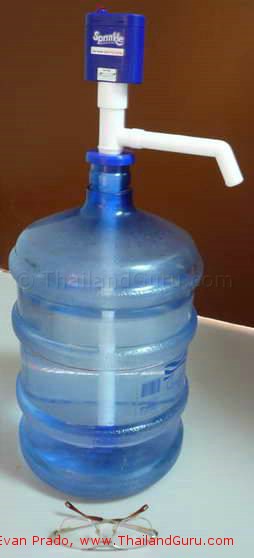
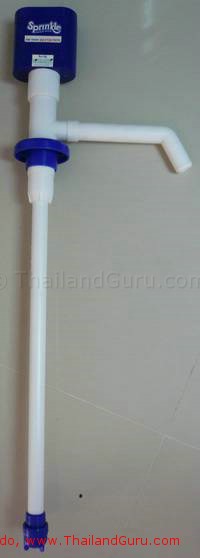 The normal way that expats handle water is by delivery of large water bottles to your residence. Typically, you subscribe to a service such as with the company Sprinkle or Singha or one of many others, and they regularly deliver bottles. I have always liked Sprinkle. We buy a batch of coupons in advance, and they come to deliver new bottles and take away empty bottles on a schedule, whereby we give them coupons or if we're not home then just leave them for the delivery person to pick up at the time they deliver new bottles and take away empty ones in front of the house or office. The same applies to condos and apartments.
The normal way that expats handle water is by delivery of large water bottles to your residence. Typically, you subscribe to a service such as with the company Sprinkle or Singha or one of many others, and they regularly deliver bottles. I have always liked Sprinkle. We buy a batch of coupons in advance, and they come to deliver new bottles and take away empty bottles on a schedule, whereby we give them coupons or if we're not home then just leave them for the delivery person to pick up at the time they deliver new bottles and take away empty ones in front of the house or office. The same applies to condos and apartments.
Thus, there is no need to haul large quantities of water from the supermarket, though of course you may do so at the start before you organize water delivery.
For help with ordering water, you can just ask your building manager, a neighborhood official, or a neighbor for information on who serves your neighborhood. In central Bangkok, you can just call the company Sprinkle at 02-712-7272, one of the best organized.
We typically keep stock of 3 big bottles at a time, but of course you can choose your own stock.
The main issue of large water bottles is handling these heavy things.
Some people buy a standup water dispenser. Picking up a big bottle and putting it on top of a dispenser is a challenge for a lady, and could injure anybody if done wrong. The vendor will usually do so happily, but he may not be around when the bottle empties and you need to pick up the next one.
I just leave the bottles on the ground and use a small pump. We just roll the bottles down our floor, but you can slide or carry them or get a dolly or whatever you prefer.
Some vendors offer a hand push pump, or a battery operated pump, like the one in the photo to the left, either free with a subscription or at a small price. I prefer a hand operated push pump, which I bought on Lazada. For the battery operated pumps, some use disposable batteries such as size D, but I bought a rechargable battery pump which uses just a cable identical to a common Android USB Micro standard. (Still, in usage, I tend to prefer the hand pump over the battery one when both are available side by side.)
Some people use water directly from the pump, but I fill a pitcher or two at a time, and reuse small plastic bottles, filling them up from the pump.
Some people boil the tap water and drink that. However, you should be advised that if there are any toxins in the water, your body may still react to the toxins after it is boiled, even if the toxins are dead already. Freezing water into ice does not kill all the bacteria and viruses.
I've been brushing my teeth with unfiltered tap water. Of course, if the water is discolored or has a smell, then I'd be careful. Sometimes, I have gotten a glass, filled it with water, looked for any color or anything (other than the normal air bubbles from filling up the glass), and smelled it. It is very rare that I've seen any problem.
Many homes put in a water filter at particular taps where drinking water may be consumed, and some also have an ultraviolet disinfection system whereby typically the water flowing thru is irradiated with 320 nanometer ultraviolet light to kill most pathogens or at least reduce them below a "minimally infective dose".
I have accidentally drunk water from a house tap which was totally untreated, and nothing happened to me. For example, on more than one occasion, I have come back from a long trip to a country where you normally drink tap water and without thinking (especially when sleepy) just filled up a glass and drunk it and then later remembered what I did and realized my mistake. No worries, there was no effect at all which I could discern. Then again, I've lived here a long time, and I still remember my body's strong reaction to the first time I drank just thoroughly boiled water the first month I was here in 1994, not poisoning but just my body's reaction to unfamiliar benign things in the water.
When eating out, the water is generally safe. In cafes and restaurants, you have an option of buying a small bottle of water for your table or getting a glass of water without the bottle. The latter generally comes from a big bottle in the back, i.e., is the same as if you order your own small bottle.
However, many street vendors and some restaurants will give you water that has a pale color. The coloring is due to a tea leaf, and in many cases signifies that it is boiled water. That is an old tradition.
It is common for vendors to purchase large quantities of ice rather than produce it themselves. Ice is produced in factories that are licensed and inspected by the government. This ice is distributed to vendors all over. There are occasionally hygiene problems in packaging, transportation and storage, but not from the ice as it was produced at the factory, and it's extremely rare that anyone gets sick from it.
Perhaps the greatest risk with water is the glass it's poured into. Is it clean?
A few Thai phrases on water:
nam plao -- plain water (no bottle)
nam kowat -- bottled water
nam tom -- boiled water
nam duem -- drinking water (could be any of the above)
nam yen -- cold water
nam kang -- ice
nam rawn -- hot water
nam un -- warm water for taking a shower (e.g., a hotel feature)
nam sohm -- orange juice
nam manow -- lemon or lime juice
Drinking Water Delivery Companies
Some water delivery companies, to deliver large bottles to your residence:
Sprinkle (my favorite): 02-712-7272
Boon Rawd (Singha): Tel: 02-258-7711
Aqua Fresh (a U.S. owned company): Tel: 02-729-4714
M Water Co. (Sprinkle Water): Tel: 02-712-7486
Siam Drinking Water: Tel: 02-322-8565
... and there are more.
Cost of Water on Utility Bills
Water in Thailand is relatively cheap. In general conversation, it will be stated in terms of price per "unit". So what's a unit? One unit equals one cubic meter which is 1000 liters.
The cost per unit is typically around 10 baht, but varies around the country, sometimes very significantly, such as up to around 30 baht in some places under some circumstances. The government rate for water can fluctuate, such as if there is a drought. The cost per unit is higher in apartments, but usually not in condominiums. (By definition of "apartment", one owner owns all the units and rents them all out, whereby you pay the building for your consumption, not the government. A "condominium" building has different units having different owners, like a neighborhood of houses, whereby owners pay the government directly for consumption.) Apartment buildings add some income to themselves by charging higher rates, but some of this goes into paying for the electricity to pump the water to higher floors and maintaining the entire system. In condominium buildings, these costs are included in the monthly building maintenance fee paid by unit owners, paid separately from the water bill.
In many places to help the poor and also to discourage wastage of water, the price of water increases with usage, e.g., the first xxx units at a very low price, the next xxx units at a higher price, and so on.
Hot Water Showers
It is conventional in Thai dwellings to not have hot water showers, though hot water showers are standard in hotels and apartments, and upper class houses and condominiums. If you don't like cold showers to wake you up in the morning, then you'd better check this out before settling upon a home, or else be prepared to install an electric hot water heater.
It is rare to have a central hot water heater in Thailand. Normally, water is heated at the exit location, as it flows thru a pipe upon usage, by a small electric hot water heater located just before the particular tap.
Water for hand washing taps, clothes washing, etc., is normally unheated, just from the tap. Since Thailand usually doesn't get very cold, it's usually comfortable. However, many luxury homes have lots of hot water heaters which automatically turn on and off with usage, such as for washing dishes, clothes, hands, etc.
If you do install an electric hot water heater, then you should be careful about how it is installed. To assure that you don't get shocked, it must be properly grounded. A combination of a cheap hot water heater and improper grounding can lead to shocking consequences. Thailand Guru has a page on grounding, and if you aren't sure about doing it yourself, then you may hire us to do it for you.
Also, if you buy a water heater, you should be aware that there are two kinds of hot water heaters:
- Located before the on/off tap knob, whereby the hot water heater turns on and off automatically according to water flow (not pressure), and
- Located after an on/off tap knob, whereby the hot water heater turns on and off automatically according to water pressure (not flow).
It is important to get the right kind of water heater for a particular application. If you are not sure, then consult somebody with a technical knack.
In luxury homes, there are often the first type (automatic flow switch), which are hidden away somewhere such as under the sink or above a ceiling, and go to the hot water tap of a 2 tap mixture, whereby you don't adjust the heater settings, it's just one setting all the time and you adjust the temperature by the mixture of the hot and cold water by your 2 knobs or your swinging bar or whatever. You will more commonly see the second type of heater (with automatic pressure switch) in less luxurious places, and located for example overtly on the wall of your shower, whereby there is just one knob on the water tap coming from the wall, controlling the water before it goes into the heater. You then you can turn just one knob on the water heater to adjust the water temperature. (You can also turn it on and off, but they normally turn off automatically when you turn off the tap and the water pressure drops.) I prefer the latter type because it's just easier and quicker to use, plus I've been able to control the water temperature better, never mind a trivial difference in aesthetics. I actually dislike the hidden heaters and fancy taps.
Water Pressure
The water pressure in most of Thailand is actually pretty low. In many Thai houses, people take showers on the ground floor, and sometimes do not shower during some times of the day due to low water pressure. You may also notice in many Thai bathrooms a large plastic water can, such as what you may buy as a main trash can or storage unit, except it's filled up with water, and has a scoop on top. This is often the shower for Thais. They let the can fill up with water over time, then when it's time to take a shower, scoop water over themselves.
In modern houses, there is normally an automatic water pump within the yard, located outside the house, which creates high water pressure in the pipe going inside the house, so that second floor showers are routine and just like overseas if not better. The pump automatically turns on when the water pressure drops, such as when you open a tap and start using water, and automatically turns off when all taps are shut and the pressure returns to a normal threshold in the pipe.
There is also a large water storage tank outside (and more than one tank for many luxury houses), usually above the ground in a corner somewhere, but in some luxury houses it is buried under the ground, plus a pump to pump the water.
The reason there is a large water storage tank is because the water pressure in many parts of Thailand can sometimes be zero -- a water outage for awhile -- so you need to start using your reserve storage of water. Some other times, the water supply can exist but be insufficient for your rate of consumption.
That's the general configuration, but then there are some details and options, especially if you are planning to supply your own water pump and tank(s) for your own house. Usually, rental houses already have that sorted, but sometimes they can have issues. The information below is geared more for people building their own home, or troubleshooting a rental home.
First of all, the bigger the pump, the higher the water pressure, though of course, you should choose an appropriately sized pump for a house or else you can burst the pipes if you buy and use a pump which is too strong. Houses which are 2 levels typically have very good water pressure on the second floor, and even better on the first floor. For houses and townhouses of 3 or more levels, things can get a little bit more complicated.
Some people pump water from the tank into the house, but rely on city water pressure to recharge the tank on the ground or under the ground. Water can trickle into the tank all day and night and accumulate, then you can use it at a much higher rate of consumption from time to time, for brief periods. However, you risk running out of water this day, especially if the city water pressure drops so that it cannot lift the water to the inlet at the top of the tank, and remains insufficient for very long.
Some people use the pump to suck in city water and pump it into the house, and don't use the tank unless the city water supply fails. Even if city water is low, a pump can pump it out and boost the pressure a lot for your home. Some brands and models of pump can pump out city water better than some other brands and models, especially when there is air in the pipe. It depends upon the mechanical design of the pump. However, when the city water pressure is very low and near failure, you can be taking a shower or doing something else and the water starts getting a lot of air in it, or goes on and off, even with very good pumps.
Some people use one pump to both fill the reserve tank and supply the house, by manually turning valves, depending upon whether they want to fill the tank or provide water to the house. For example, turn the valves one way and the pump inlet is from the city, and the pump outlet can be either to the house or to the tank. Switch valves another way and the inlet can be the tank and the outlet the house.
I do things an unusual way. I have 2 pumps. I don't mess with valves a lot. Pump #1 supplies the house, and pump #2 only supplies the tank. Actually, pump #1 can have its inlet switched to be either from the city (bypassing the tank) or from the tank. However, usually I don't mess with switching valves. I like getting my water from the tank because it's smoother. I usually get all my water from the tank. Pump #2 has a sensor with 2 settings so that when the tank water level drops to a certain level, pump #2 turns on and stays on until the water rises to a particular level set by the other sensor.
In contrast, a one pump system without sensors, whereby city water fills the tank based on city water pressure, typically has a toilet-like float controlling a valve at the top of the tank, to keep the water tank level high.
Finally, there is troubleshooting. I hear a lot of pumps, in rental houses, rich owner houses, and elsewhere, automatically turning on and off very quickly all night when nobody is using the water, such as every 1 minute, or every 40 seconds, or some consistent time interval. This is because of back flow. The pump raises the pressure in the house pipes, but then water trickles backwards. The pressure drops, then it pumps again. This can disturb peoples' sleep, such as neighbors if not yourselves, and also cause unnecessary wear and tear to the pumps, reducing their lifetime.
That back flow of water could be going back into the city pipe, and/or back into the storage tank.
The solution is to install one way valves onto the pipes, both near the city water inlet and at the storage tank outlet. If they are already installed, then replace them. Sometimes minerals from the water can reduce the seal of the one way valve.
If you are building a home and would like a more detailed consultation, then you may contact me.
Notably, some communities and properties in the countryside and old suburbs may also have a raised central water tank to provide local pressure by gravity, located on top of a platform, which by its nature is a prominent landmark. See some photos below. However, this is unusual in modern Thailand. Pumps on individual properties are by far the most common way of providing water pressure into houses.
It's also worth noting that occasionally I've encountered a condominium unit with poor water pressure. It is possible to install a small water pump inside your unit, but if you do this, be very careful because it should not be a strong water pump, so that it doesn't burst any pipes, and I suggest you have a switch whereby you can turn it off (or unplug it) when you are away.
The water pressure is not the same in all levels of a high rise building or hotel which provide their water pressure by gravity feed from central tanks. For example, builders would not just put tanks on the roof of a tall high rise and supply all the water to a whole building, because the water pressure would be far too high at lower floors. Normally, in a high rise, there are multiple tanks located at different levels of a building, each providing water to only the floors immediately below each tank, but not too far below them. Thus, you might notice fairly low pressure on one floor (nearer the tank) but high pressure on another floor (further below the tank).
If you are a renter, then I recommend that once you choose a particular place to rent and consider closing a deal, that you check the water pressure and water supply system before you sign off on the deal and give your money and move in.
Water, Water Everywhere...
Water is one of the basic building blocks of life as we know it in this universe, and our planet has an abundance. As a scientist myself, I understand these things, but I will spare you that discussion here. :-)
In Thailand, water supply is exceptionally plentiful, except in the northeast in the dry seasons. Thailand's culture has long been intimately related with water, but not in a seafaring way, instead mainly in a local transport and irrigation mindset.
The land is flat in Bangkok and the surrounding provinces, and if you just look at a map then you will see an endless web of straight blue criss-crosses, called "klongs", the Thai word for "canals". You may find a lot of canals close to your home which you may not have thought much about. They are usually very old and silted up by now, though they still have water. Countless klongs are very long, continuing well beyond the biggest maps of greater Bangkok. Just appreciating them on an ordinary map will give you a better feel for Thai culture and history, much of it unwritten.
For transport, Thais didn't use the wheel/horses/buffaloes/elephants much around Bangkok in the old days, compared to boats. The water table in Bangkok is very high. Just dig a ditch and watch water fill in. If the old Thais wanted a "road", they just dug it, and it doubled as irrigation for crops. If the old Thais wanted a vehicle, then they just carved a canoe and paddle or pole out of a tree. If you want to see old Bangkok, then just go to some remote places on the map and take a look at the homes around the canals.
Other provinces have similar networks.
Around 5,000 years ago, Bangkok was under water and the seaside went up to a bit north of Bangkok. Remote sensing technology discovered a network of canals to the north towards Saraburi which was extensive, but which dried up maybe thousands of years ago. Moats can be discerned around them, there is previously sunken pottery in them, etc. River silt from erosion and a geological plate rising led to more land emerging.
The Thai language is rich in water related phrases as metaphors.
In the 20th century, modern technology was applied to the waterways, for better and worse. Floodgates, pumps and dams manage the water better (but sometimes the dams pose ecosystem disasters). On the other hand, pollution has transformed so many waterways into open sewers.
Most of the drinking water in bottles comes from deep underground aquifers, and that water is very old and clean. Many communities get tap water from aquifers, but application of technology has led to local sinkhole communities and resultant flooding during the rainy season.
However, I have noticed over the decades that some drinking water has just come from the taps and been sanitized and bottled by various entities. This is actually good because pumping out ground water in some places can cause the ground to sink, and then flooding during the rainy season, so tapping aquifers in many places in Bangkok has been discouraged.
(I have known some people who performed geophysical surveys to map underground aquifers in order to determine where to drill ... and where to locate those tall water tanks you see around the outskirts of Bangkok and in the provinces. They are tall to create water pressure. However, when it was realized that Bangkok was sinking, that pretty much ended in Bangkok, though it is still common upcountry at elevations well above sea level.)
 This water tank looks like a giant golf ball on a tee. In fact, it is located right next to an old golf course in a nice neighborhood of luxury homes! It's surprising that they didn't paint it to look like a golf ball on a tee, e.g., with many spots using silver metallic paint. If you know someone who does that kind of paint work, then they can find the place by just driving down the Chaeng Wattana elevated expressway to Rangsit in northern Bangkok. This photo was taken from a car on that expressway. It looks even better close up from the ground.
This water tank looks like a giant golf ball on a tee. In fact, it is located right next to an old golf course in a nice neighborhood of luxury homes! It's surprising that they didn't paint it to look like a golf ball on a tee, e.g., with many spots using silver metallic paint. If you know someone who does that kind of paint work, then they can find the place by just driving down the Chaeng Wattana elevated expressway to Rangsit in northern Bangkok. This photo was taken from a car on that expressway. It looks even better close up from the ground.
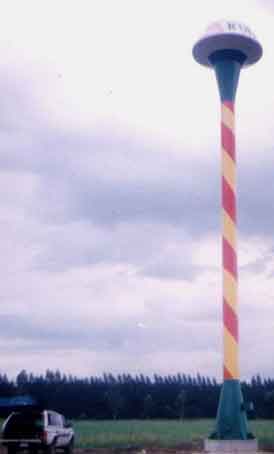
The photo to the left is a boring "champagne" tank. Doesn't look like a champagne glass to me...
When I was working in the engineering and construction sector in the 1990s, I also attended a presentation by a professional civil engineer who gave quite a detailed presentation. One part was about the kinds of pathogens in pipe water, why it can vary, how much is destroyed by UV radiation in typical home water purification systems of that sort, and other interesting issues. While it may leave the water processing center conforming to WHO standards, a main problem is pipes which are not completely sealed, and which may harbor pathogens around cracks and breaks in seals. When water pressure is high, it may be insignificant, but if there is suction in the pipe then it can be sucked out.
Especially in Bangkok, when the water stops running, if you are not prepared with an alternative water supply, then you may note that there is actually a suction in your tap. If you put your hand to the tap and turn it on, it actually sucks on your skin a little. This is because many buildings and houses have pumps which continue trying to pump even when there's no water in the pipes. Many multi-level buildings have water tanks on the roof and various levels to provide water to their residents, and powerful pumps to pump the water very high to those tanks. When the waterworks utility fails to deliver water in the pipes, then many of the pumps don't stop pumping. Instead, they start sucking air, causing a suction in the pipes, which in turn sucks in dirt ... and bacteria ... from places where the pipes have imperfect seals or cracks. (Normally, good water pressure in the pipe keeps that inward leakage as insignificant.) The result is that when water comes again, it first washes out all the stuff that was sucked into the pipes, which is dirt and maybe significant pathogens.
There are different kinds of aquifers. Pumping out underground water can cause the surface to sink. However, some are stable, e.g., aquifers located in faults.
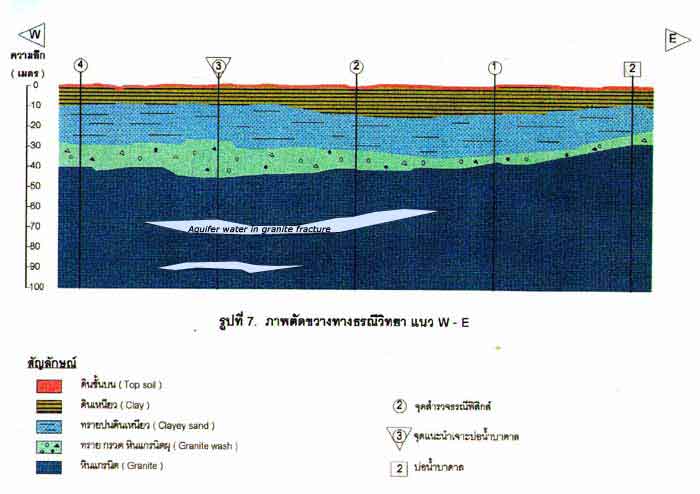
Below, the quality of water with depth (meters), in a place near Bangkok.
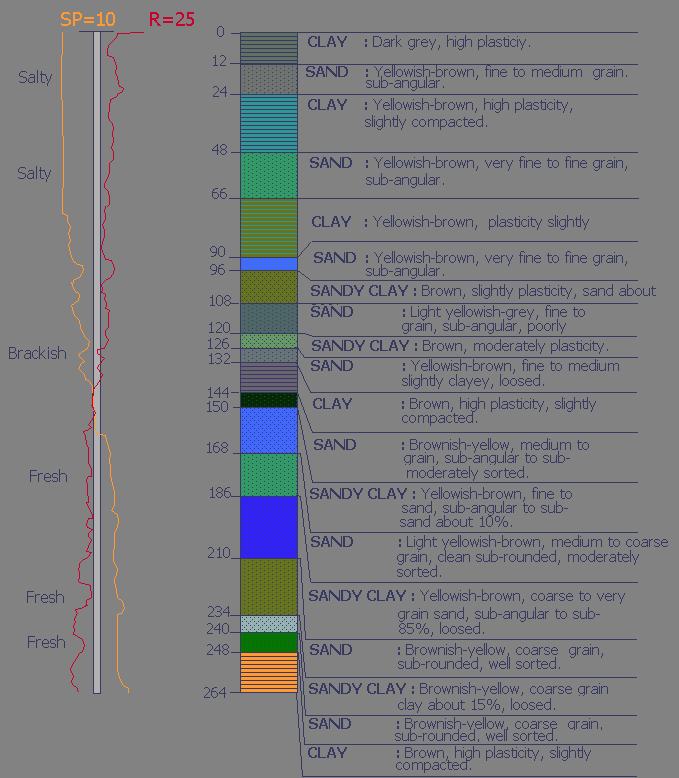
See also our page on Boat transport in Bangkok
 > Utilities, Govts, Money, Misc. > Water
> Utilities, Govts, Money, Misc. > Water
Copyright 1999 -
2025 by Mark Evan Prado, All Rights Reserved.
Notably, I get quickly notified of copies of tracts by the CopyScape / CopySentry automatic search engine & notifier.
Short quotes are often OK and can be approved, if there is a clear reference and web link back to my website from the quoted material, and if you send me a short message. I try to help people with good intentions, and try to help the world. Not thieves. Links back to this website are helpful for sustainable progress, thank you!
Please have honor and class by following intellectual property and internet protocols. Be a good kind of person in life.
|
Want to privately ask the Thailand Guru? Contact us.
|
|
Some of the services discussed on Thailand Guru are provided by our friendly staff in our 2 companies: |
|
|
Lucky Lion Pride Co., Ltd.
|
|
| DISCLAIMER: Although efforts have been made to ensure the information on this website was correct at the time of electronic publication, ThailandGuru and all its associates do not assume and hereby disclaim any liability to any party for any loss or damage caused by errors, omissions or misleading information resulting from negligence, accident or any other cause. If you choose to take any of this advice, it is at your own risk and no other entity's. ThailandGuru and its associates will take no responsibility. The only thing we guarantee is that our website information can take bandwidth, memory and/or disk space, at least temporarily. Guru is relative. | |
Menu: Site Map